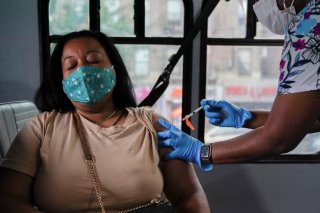Three and Done? CDC Says Americans May Not Need Boosters After Third Shot
Cases are increasing by more than 5 percent in forty-two states, while nearly 90,000 coronavirus-infected patients are being treated in hospitals across the United States.
There is a possibility that Americans may not need annual coronavirus booster shots after a third jab, according to the director of the U.S. Centers for Disease Control and Prevention (CDC).
“This virus has been humbling, so I don’t want to say never, but we are not necessarily anticipating that you will need this annually,” CDC chief Dr. Rochelle Walensky said in an interview Thursday on CBS’ This Morning.
“It does look like after this third dose, you get a really robust response, and so we will continue to follow the science both on the vaccine side but also on the virus side,” she added.
Her comments come on the heels of other top U.S. health officials confirming that they plan to start offering booster shots to all eligible Americans eight months after their second jabs, as data from recent studies are suggesting that vaccine protection diminishes over time.
The latest estimates indicate that a shade over 50 percent of Americans are fully vaccinated against the coronavirus. While inoculations have been increasing in recent weeks, millions are still firmly opposed to getting vaccinated.
Winter COVID Surge
Meanwhile, Dr. Scott Gottlieb, the former commissioner of the U.S. Food and Drug Administration, noted on CNBC’s Squawk Box Thursday that he is anticipating health officials will try to administer the booster shots before any winter Covid-19 surge.
“The first two (doses) were administered so close together, they really qualify as two primes,” he said. “And this is the booster that’s hopefully going to induce a longer-term immunity, more durable immunity,” he continued.
Delta Concern
The highly transmissible Delta variant, first detected by scientists in India last fall, already has spread to more than 140 countries. After being identified in the United States just a few months ago, the variant is now responsible for more than 95 percent of all sequenced cases, according to the CDC.
The seven-day average of daily new coronavirus cases in the country is roughly 141,000—which is eleven times higher compared to just two months ago and 14 percent higher compared to the week prior, according to data compiled by Johns Hopkins University.
Cases are increasing by more than 5 percent in forty-two states, while nearly 90,000 coronavirus-infected patients are being treated in hospitals across the United States.
The CDC has suggested that more than 90 percent of the entire U.S. population lives in an area with high coronavirus transmission rates.
“We continue to see a rise in cases driven by the more transmissible Delta variant with cases concentrated in communities with lower vaccination rates,” White House coronavirus response coordinator Jeff Zients said Wednesday during a virtual Covid-19 briefing. “So, this remains a pandemic of the unvaccinated.”
Ethen Kim Lieser is a Washington state-based Science and Tech Editor who has held posts at Google, The Korea Herald, Lincoln Journal Star, AsianWeek, and Arirang TV. Follow or contact him on LinkedIn.
Image: Reuters.

